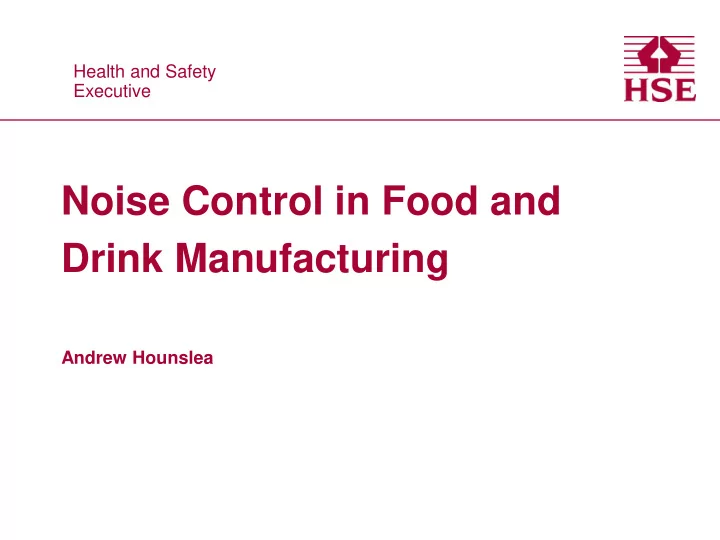

Health and Safety Health and Safety Executive Executive Noise Control in Food and Drink Manufacturing Andrew Hounslea
Contents • Basic Noise Control • Source • Path • Receiver
Basic Noise Control • Noise exposure is a combination of noise level and the time that an individual is exposed to that noise. • A 3dB reduction in noise level will result in a halving of exposure if the exposure time remains constant. – A 3dB change is barely noticeable
Basic Noise Control • Source – Usually the most effective • Path – Can be ‘open to abuse’ and is often retrofitted at significant cost. • Receiver – NOT Hearing protection
Role of Hearing Protection • As an interim measure while noise control is being implemented. • Where noise exposure is as low as reasonably practicable but still above the Upper Exposure Action Value (UEAV). – UEAV is an L EP,d of 85 dB(A).
Some Typical Noise Sources – Food prep machinery (esp. peelers, slicers, cutters) – Conveyor belt noise (conveyors, products on conveyors, containers on conveyors) – Use of compressed air (for cleaning, drying, moving etc.) – Use of injected steam for heating – Impact noise (products on sheet steel, chutes and containers) – Panel resonances – Pressure washing
Examples of Controlling Noise at Source • Impact Noise • ‘Sound - deadened’ Steel • Compressed Air Use • Maintenance • ‘Buying Quiet’
Source - Impacts • Boiled sweets impacting on metal trays. Replace metal with plastic. 4-5 dB reduction in noise levels.
Source - Impacts • Damping material in hoppers and chutes in a multi-head weigher. 8 dB reduction in noise levels.
Source – Reduce Drop Heights • Lower drop height, lower noise levels from the resulting impact.
Source – Sheet Stainless Steel • Damping material on stainless steel or ‘sandwich’ construction.
Source – Compressed Air • Compressed air used to clean conveyor belt. • ‘Quiet nozzles’ reduced noise level by approximately 10 dB.
Source – Compressed Air • Hand-held Air-Lines • 10 dB reduction in noise levels
Source – Compressed Air • Air exhausts can be fitted with silencers to reduce noise. A wide variety of silencers are available. • Leaking air lines can produce significant noise levels unnecessarily. – A total waste of compressed air and money.
Source - Maintenance • Fruit juice pump producing noise of 103 dB(A). • Maintenance performed on pump including replacing bearings. • 27 dB reduction in noise levels
Source – Buy Quiet • Have a low-noise equipment purchasing and hire policy. – Avoid the need for retrofitting noise controls. • Have a noise specification for tendering suppliers to meet. • See HSE Buy Quiet Webpages: http://www.hse.gov.uk/noise/buy- quiet/index.htm
Examples of Controlling the Noise Path • Potential Noise Transmission Routes • Enclosures • ‘Plastic Strip Curtains’ • Isolation • Reverberant Noise
Path – Potential Routes
Path - Enclosures
Path – Enclosure/Segregation • Plastic strip curtains
Path – Isolation • Isolation from the building and other structures.
Path – Reverberant Noise • Incorporate noise absorbing materials into walls and ceilings.
Examples of Controlling Noise at the Receiver • Remote Working • Controlling the Exposure Duration • Distance
Receiver – Remote Working • Workers monitor and operate machinery from a noise refuge. 30 dB reduction in noise levels from outside to inside.
Receiver – Other Tactics • Limit the time spent in noisy areas. • Ensure commonly used walkways are outside noisy areas. • Increase the distance between workers and noisy machinery.
Sources of Advice • Search ‘top 10 noise’ on the HSE Internet Site (www.hse.gov.uk) • HSG 232 – Sound Solutions for the Food and Drink Industries • Other case studies on HSE Noise website (www.hse.gov.uk/noise) • Guidance on the Control of Noise at Work Regulations 2005 – L108 (http://www.hse.gov.uk/pUbns/priced/l108 .pdf)
Health and Safety Health and Safety Executive Executive Any Questions? andrew.hounslea@hse.gov.uk
Recommend
More recommend